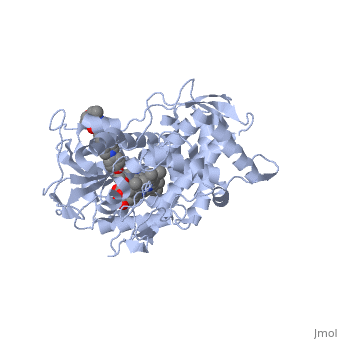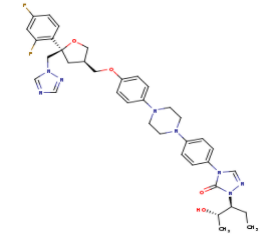Sandbox 123456
From Proteopedia
(Difference between revisions)
| Line 3: | Line 3: | ||
==Introduction== | ==Introduction== | ||
Noxafil, also known as posaconazole, was developed by Schering-Plough in the mid-2000s <ref name="acs">Posaconazole. (2011, December 12). Retrieved from https://www.acs.org/content/acs/en/molecule-of-the-week/archive/p/molecule-of-the-week-posaconazole.html?_ga=1.240614083.1136742914.1490798730 </ref>, and is a broad spectrum antifungal drug mainly used to treat fungal infections caused by ''Candida'' and ''Aspergillus'' species and derived from a similar triazole antifungal agent, Itraconazole. It is especially effective against filamentous fungi. Noxafil is also often used when other antifungal medicines are not able to be tolerated or if the patient is immunocompromised. Noxafil falls under the triazole class of antifungal drugs and thus works through inhibiting the biosynthesis of ergosterol in the fungal cell membrane, an essential factor that if inhibited, will lead to prevention of cell growth and ultimately death <ref name=pubchem>National Center for Biotechnology Information. PubChem Compound Database; CID=468595, https://pubchem.ncbi.nlm.nih.gov/compound/468595</ref>. | Noxafil, also known as posaconazole, was developed by Schering-Plough in the mid-2000s <ref name="acs">Posaconazole. (2011, December 12). Retrieved from https://www.acs.org/content/acs/en/molecule-of-the-week/archive/p/molecule-of-the-week-posaconazole.html?_ga=1.240614083.1136742914.1490798730 </ref>, and is a broad spectrum antifungal drug mainly used to treat fungal infections caused by ''Candida'' and ''Aspergillus'' species and derived from a similar triazole antifungal agent, Itraconazole. It is especially effective against filamentous fungi. Noxafil is also often used when other antifungal medicines are not able to be tolerated or if the patient is immunocompromised. Noxafil falls under the triazole class of antifungal drugs and thus works through inhibiting the biosynthesis of ergosterol in the fungal cell membrane, an essential factor that if inhibited, will lead to prevention of cell growth and ultimately death <ref name=pubchem>National Center for Biotechnology Information. PubChem Compound Database; CID=468595, https://pubchem.ncbi.nlm.nih.gov/compound/468595</ref>. | ||
| - | |||
==Function/Structure== | ==Function/Structure== | ||
| Line 13: | Line 12: | ||
The primary component of Noxafil, <scene name='75/756730/Posaconazole/1'>posaconazole</scene> is a potent, broad-spectrum antifungal drug. It was derived from a similar triazole antifungal agent, Itraconazole. The differences in structure are that the chlorine substituents in the aromatic ring on the left-hand side of the images are replaces with fluorines and that the triazolone sidechain is hydroxylated in the posaconazole structure<ref name="drugbank">Posaconazole. (n.d.). Retrieved from https://www.drugbank.ca/drugs/DB01263 | The primary component of Noxafil, <scene name='75/756730/Posaconazole/1'>posaconazole</scene> is a potent, broad-spectrum antifungal drug. It was derived from a similar triazole antifungal agent, Itraconazole. The differences in structure are that the chlorine substituents in the aromatic ring on the left-hand side of the images are replaces with fluorines and that the triazolone sidechain is hydroxylated in the posaconazole structure<ref name="drugbank">Posaconazole. (n.d.). Retrieved from https://www.drugbank.ca/drugs/DB01263 | ||
Accession Number: DB01263 </ref>. The extended side chain residues and hydrophobic contacts enhances antifungal activity by allowing tighter binding affinities to the <scene name='75/756730/Hemegroup2/1'>heme cofactor</scene> in the active site of the CYP450-dependent enzyme 14-alpha-demthylase (<scene name='75/756730/Cyp51/1'>CYP51</scene>) <ref name="groll">doi:10.1586/14787210.3.4.467</ref><ref>doi: 10.1086/523576</ref>. The tighter binding affinity of posaconazole makes it less susceptible to be affected by mutations in the enzyme resulting in resistance of fungi <ref name="formularyjournal">Sircar-Ramsewak,, F., Nicolau, D. P., & Kuti, J. L. (2005). Focus on posaconazole: A novel triazole antifungal for the treatment of invasive fungal infections. Formulary Journal - Modern Medicine Network </ref>. The entirety of the scene shows the crystal <scene name='75/756730/Structure/1'>structure</scene> of sterol 14-alpha demethylase (CYP51) from a pathogenic yeast Candida albicans in complex with the antifungal drug posaconazole (PDB ID: 5FSA). | Accession Number: DB01263 </ref>. The extended side chain residues and hydrophobic contacts enhances antifungal activity by allowing tighter binding affinities to the <scene name='75/756730/Hemegroup2/1'>heme cofactor</scene> in the active site of the CYP450-dependent enzyme 14-alpha-demthylase (<scene name='75/756730/Cyp51/1'>CYP51</scene>) <ref name="groll">doi:10.1586/14787210.3.4.467</ref><ref>doi: 10.1086/523576</ref>. The tighter binding affinity of posaconazole makes it less susceptible to be affected by mutations in the enzyme resulting in resistance of fungi <ref name="formularyjournal">Sircar-Ramsewak,, F., Nicolau, D. P., & Kuti, J. L. (2005). Focus on posaconazole: A novel triazole antifungal for the treatment of invasive fungal infections. Formulary Journal - Modern Medicine Network </ref>. The entirety of the scene shows the crystal <scene name='75/756730/Structure/1'>structure</scene> of sterol 14-alpha demethylase (CYP51) from a pathogenic yeast Candida albicans in complex with the antifungal drug posaconazole (PDB ID: 5FSA). | ||
| - | |||
==Mechanism== | ==Mechanism== | ||
| Line 24: | Line 22: | ||
== Relevance == | == Relevance == | ||
| - | Invasive fungal infections, commonly caused by | + | Invasive fungal infections, commonly caused by ''Candida'' or ''Aspergillus'' species affect patients that are immunocompromised such as those with different pre-existing infections or more seriously for those with immunologically suppressing diseases like HIV/AIDS. ''Candida'' (thrush/Candidiasis) is the most common yeast pathogen that typically grows in human mucosal surfaces like the intestinal tract and causes pathology when it becomes overgrown. "Aspergillus" is the most common mold pathogen leading to invasive fungal infections, termed Aspergillosis, when it is acquired from the surrounding environment <ref name="soysal">doi: 10.2147/IDR.S65592</ref>. Noxafil oral suspension is the best form of treatment for invasive Candida and Aspergillus infections in patients 13 years and older who are severely immunocompromised. Noxafil is also more effective at preventing invasive fungal infections in immunocompromised patients when compared to other antifungal treatments (fluconazole and itraconazole)<ref name="dekkers">doi: 10.1007/s12281-016-0255-4</ref> . Overall, Noxafil displays fewer cases of invasive fungal infections and is also a more affordable treatment for immunocompromised patients. (Add more & add citations). There has been a noticeable increase in the incidence of invasive fungal infections particularly within patients receiving chemotherapy and transplant recipients. These patients are extremely susceptible because of their compromised immune system and the pressures from antibiotic usage, which is why invasive fungal infections are on the rise with these medical advances <ref name= "dekkers"/>. |
== References == | == References == | ||
<references/> | <references/> | ||
Revision as of 21:24, 19 April 2017
| |||||||||||


